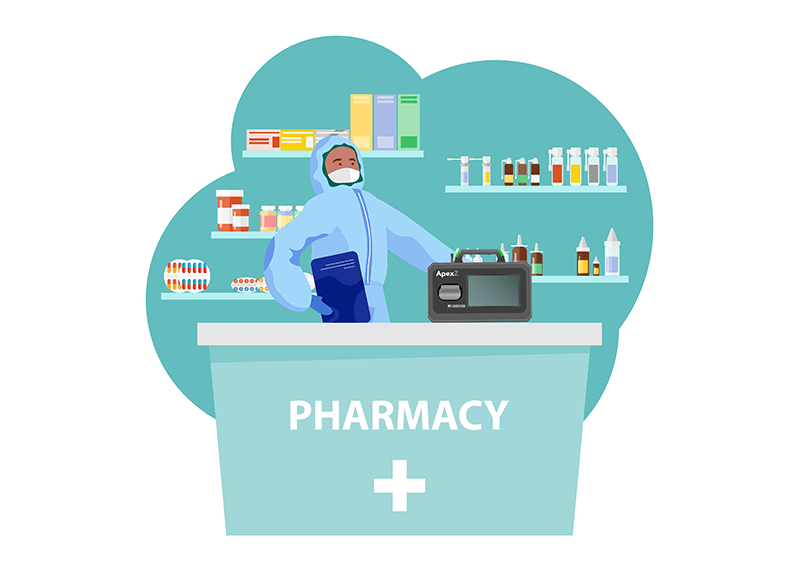You probably don’t think of pharmacies as cleanrooms or controlled environments, but that’s because you are most likely thinking of community pharmacies! Community pharmacies are generally where generic prescriptions are sent and are readily available throughout the United States. There are roughly 56,000 community pharmacies in the states, but only 7,500 of those specialize in compounding.
So what exactly are compounding pharmacies? These are pharmacies where medications are customized or modified to meet specific needs. If you need a medication that is not commercially available, a compounding pharmacy can make it for you. They even make medication for pets!
Who Needs A Compounding Pharmacy?
There are a number of people who benefit from compounding pharmacies. For example, you might need a compounding pharmacy if you are allergic to an inactive ingredient in a medication. A compounding pharmacist can make that medicine without that ingredient.
Compounding pharmacies are specifically useful if you have a child who needs medication but does not enjoy the process. Compounding pharmacies can turn a pill into a gummy or liquid, making it easier to take. They can also add flavor to medication to improve the taste or change the dosage.
A significant contribution of compounding pharmacies is improving accessibility. They make critical medications which could be unavailable or on back order at traditional community pharmacies.
Is A Compounding Pharmacy A Drug Manufacturer?
Compounding pharmacies are not drug manufacturers. They receive mass produced drugs from the manufacturers, who make FDA approved drugs, and then customize them to meet the patient’s exact needs. Compounding is conducted by or under the supervision of a pharmacist, who must be licensed by their state board of pharmacy. They can only dispense these drugs based on a prescription from a provider.
Sterile Vs Non-Sterile Compounding Pharmacies
Some compounding pharmacies are sterile operations, while others are non-sterile. Those who are conducting non-sterile operations are usually compounding ointments, creams, liquids, or capsules. On the other hand, pharmacies who are compounding medications for use in the eye or injection directly into the body or blood need to use sterile processes.
Those who work in the medical field are no strangers to sterile processes; however, compounding pharmacies where sterility is important must follow cleanroom procedures. They even fall under ISO cleanroom classifications.
Why Does Monitoring Matter In A Compounding Pharmacy?
In compounding pharmacies where sterile medication is handled, particle monitoring is critical. These pharmacies are operating under cleanroom standards, which means they must conduct regular or continuous monitoring to ensure they meet their classification standards.
Sterile medications are usually either injected straight into the body or blood or taken through the eye, which means they bypass the body’s natural barriers: the skin or digestive tract. While some contaminants can cause illness when ingested, that is not the primary concern and other precautions are taken for those contaminants. Sterile operations are used to prevent microscopic contaminants from being injected directly into the body, which can cause massive harm.
Routine or continuous monitoring ensures the critical workspaces are clean and functional for the desired operations.
USP Requirements
The United States Pharmacopeia (USP) has a number of criteria that compounding pharmacies must adhere to. It specifically refers to two areas: critical and supporting areas.
Critical areas are central locations where sterile manipulations are performed. The USP requires laminar (or unidirectional) airflow in these areas, which is standard cleanroom practice. Airflow should be designed to remove contaminants from cleanzones, not bring them into it. And that’s exactly what these areas are: cleanrooms. The USP requires these areas to abide by ISO 5 standards. This means there should be no more than 3,520 particles with a size of 0.5 microns and larger in each sampled cubic meter of air. The USP specifies these requirements are to apply to the immediately surrounding areas of the worksite, including within the airflow and during filling or closing operations.
The surrounding areas are considered supporting clean areas, which have a number of classifications and functions. This is typically where non-sterile components or equipment are handled and processed. These are less strict areas, but they must meet ISO 8 standards, or cleaner, depending on the area’s application.
The USP requires that critical areas be classified every 6 months. This means that samples are taken from critical locations and an average of those results is considered. But that does not replace routine monitoring. Daily or continuous monitoring ensures that particle contamination is kept within the classification limits and is considered best practice.
If you want to know more about cleanroom classifications, you can reference ISO 14644 directly. This is ISO’s standards for cleanrooms, associated clean environments, their operations, classifications, maintenance, and more. It is a comprehensive document that goes in depth on navigating cleanrooms. It is considered the best international standard.
How Can You Optimize Compounding Pharmacy Monitoring?
The best way to optimize your compounding pharmacy’s monitoring is to implement a continuous environmental monitoring system. This will ensure that your pharmacy is always meeting classification standards and note any deviations. With this information, you can…
- Identify any medications which may have been contaminated with dangerous particles.
- Note trends and determine the cause of contamination in the pharmacy, such as a specific person who might now be following gowning protocols.
- Stop contamination from affecting more products when it is present.
There are numerous and powerful benefits to continuous monitoring, but first, it’s important to understand that this can literally be life or death. It can be easy to adopt a cavalier attitude towards contamination if nothing bad has happened in your pharmacy yet, but that does not mean nothing will ever happen.
The good news is that it does not have to be difficult to start taking contamination monitoring seriously. LWS offers powerful and versatile products, like the ApexZ, designed to make monitoring simple. This lightweight, small, self-contained particle counter is not only mobile but easily connected to a number of existing computer systems.


